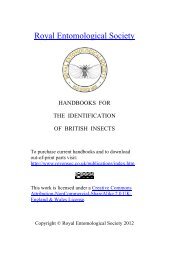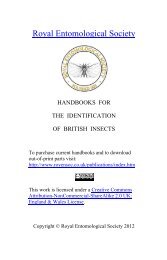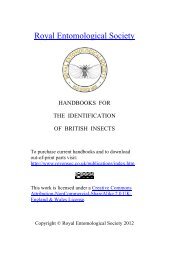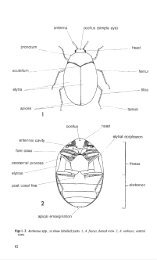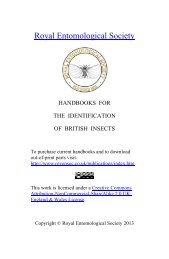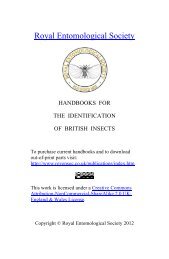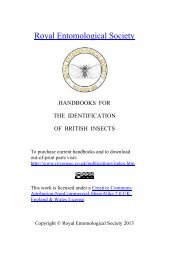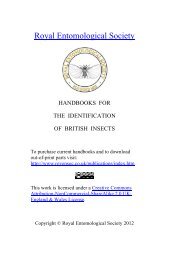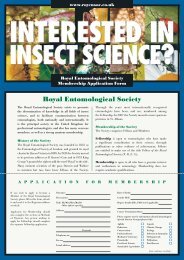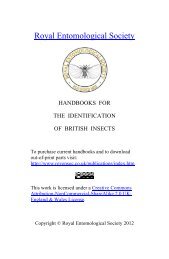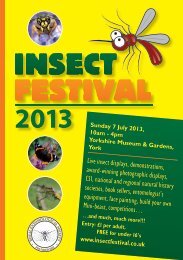Vol 5 Part 12. Coleoptera. Cerambycidae. - Royal Entomological ...
Vol 5 Part 12. Coleoptera. Cerambycidae. - Royal Entomological ...
Vol 5 Part 12. Coleoptera. Cerambycidae. - Royal Entomological ...
- No tags were found...
Create successful ePaper yourself
Turn your PDF publications into a flip-book with our unique Google optimized e-Paper software.
2 V (12). COLEOPTERA: CERAMBYCIDAEplantations and scattered trees of ornamental value ; Hylotrupes bajulus(Linnaeus) (the "House Longhorn ") may prove to be a notable exception;in many countries this species has caused severe and widespread damage,especially to structural timbers of houses. In this country, however,infestation so far appears to be confined to a few areas. Some species suchas those of Rhagium and Arhopalus, however, are beneficial to forestry, asthey speedily break down old stumps and logs.ADULT HABITS.Many species of Cerambycids appear to require a certain amount ofnourishment in the adult stage. Most LEPTURINAE, for example, assemble onflower-heads to feed on pollen, whereas many Lamiids feed on leaves andstems.Copulation usually occurs a day or so after the emergence of the adultsfrom their pupal cells ; this usually takes place on the branches or boles ofthe host trees, although in the case of the LEPTURINAE it frequently takesplace on flower heads, often some distance away from the host trees.Oviposition is performed on bark, in cracks of bark or wood, in oldemergence holes, in stems of plants, or even in the soil. Certain speciesexcavate special egg cavities with their mandibles or bore holes with theirovipositor to accommodate the eggs.When molested, many species stridulate audibly. This is accomplishedusually by the striate area of the produced mesonotum being scraped by aseries of sharp ridges on the posterior margin of the pronotum as the latteris raised or lowered.A few species, particularly those ofthe Callichromini, possess the facultyof scent emission. The scent emitted is usually pleasant, as in Aromiamoschata (Linnaeus) (the British " Musk beetle"), although in the case ofAgapanthia villosovi·ridescens Degeer it is less agreeable, resembling thesmell of snuffed candles. The scent glands are situated in the metathorax,the apertures being visible on the metasternum.EGGS.Cerambycid eggs are usually slender, cylindrical, fusiform or elongateovoid, with rounded ends. The chorion may be smooth or rugose (oftenmicro-reticulate), the usual colour being white or pale yellow. The incubationperiod for most species is approximately 14 days.LARVAE.Cerambycid larvae are soft whitish grubs with powerful mandibles andare generally recognizable by their subcylindrical, elongate tapering form.The thoracic legs, when present, are short or vestigial, the ventral mouthpartsare protracted and the mandibles are gouge-shaped or wedge-shaped.Some of the abdominal segments bear dorsal and ventral ampullae (i.e.,tuberculate protuberances to assist in locomotion). Spiracles are of theannular bilabiate type. The terminal urogomphi, when present, are neversegmented.The first-instar larvae generally differ from those of later instars in thatthey possess biforous spiracles and abdominal egg-bursting spines (Duffy,1949).




